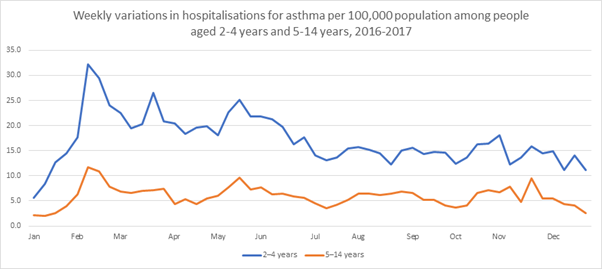Each year there is a big spike in hospital presentations and doctor visits for children who have asthma, particularly in those first few weeks after school goes back. As part of our annual Back to School campaign, we can help you best prepare to avoid becoming one of these numbers.
Good routine is key
While on school holidays it can be easy to become complacent and get out of routine with your asthma management.
Holidays are a good time to visit your doctor for an asthma review and to update your written Asthma Action Plans. So, if you didn’t get a chance to do it over the holidays, be sure to make an appointment with your doctor as soon as you can.
Beware viruses and colds still lurk around in summer
It’s not just COVID-19 to be aware of but all the other common viruses and colds too and we know children have a habit of picking everything up.
Any cold or virus can trigger the airways which increases inflammation and the risk of potential asthma flare-ups.
When children all mingle again at school, they can re-introduce germs and viruses to each other.
Stay at home when sick, encourage your child to wash or sanitise their hands regularly, avoid touching their faces, and sneeze or cough into their elbow (or tissue and throw it away and sanitise) and follow COVID safe hygiene practices.
Foods that can help or hinder asthma at school
A healthy and varied lunchbox with a range of fresh foods, including fruit and vegetables, will help overall health. View our blog on healthy lunchboxes for people with asthma here.
For children, dairy is an important part of their diet to make sure they are getting enough calcium for their growing bones and bodies.
Some people raise concerns milk or yoghurt triggers their asthma. There is little evidence to support this, but some people can have allergies to cow-milk or other dairy proteins, and we know how closely allergies and asthma are linked, and how important it is to have both under control.
If you think your child may be triggered by a certain food, visit a doctor or allergy specialist for testing and ensure your asthma and allergy management plans work in unison.
Nutritionists recommend a balanced and well-rounded diet, including dairy, for young people with asthma.
Dust and air quality in the classroom
Poor air quality is a trigger for many people with asthma.
If the outside air quality is poor – such as during fires, hazard reduction burns or at times of extreme temperatures or humidity – staying inside with air-conditioning on recycled air setting may help.
Outside activities should be avoided if the air quality is poor.
Portable air cleaners can also assist for rooms with a smaller volume of air.
Ask your school if they have an air quality plan in place.
If dust or environmental triggers like pollens at the school are a trigger for your child and they are experiencing hay fever at school or home, ensure you discuss this with their doctor.
Uncontrolled hay fever can lead to uncontrolled asthma. Discuss with their doctor the best treatment options for your child based on their symptoms, frequency, and severity.
Emotion and stress at school
For some young people, intense emotions or stress can trigger their asthma.
A fit of laughter, immense grief, crying, stress, anxiety, or depression can lead to flare ups for some, especially feelings of panic where they feel it is difficult to catch their breath.
Psychologist Peter Diaz says there are links between mental health and asthma.
“I can’t say that I ever experienced asthma without anxiety,” he says. “I’ve never seen anyone having an asthma attack who is not anxious. There are strong links.”
When some children return to school, they can experience strong emotions, so it is important to monitor not only their mental health but also their asthma.
Download our information brochure on anxiety, depression, and asthma here.
Sports classes at school and asthma
Returning to sports, especially unfamiliar sports, can impact some people’s asthma.
Exercise-induced bronchoconstriction (known as EIB) happens in 90 per cent of people with asthma and also occurs even for people who don’t have asthma.
This is when you might cough, wheeze, and have a feeling of chest tightness after exercise.
If your child is having these difficulties when participating in sport or running around the playground, it is worth checking in with your doctor again.
It is important that your child’s teachers and sports coaches are aware of if exercise is a trigger for your child’s asthma, to ensure they are prepared should an asthma incident occur.
Read more on EIB here.
Asthma Australia’s Back to School campaign
We want to halve avoidable hospital presentations for asthma by 2030.
Part of this goal means providing education and resources to parents, carers, health professional, educators and schools to manage asthma prevention for children.
Visit our website for more information and resources about asthma in children.
Image source: https://www.aihw.gov.au/reports/chronic-respiratory-conditions/asthma/contents/asthma
Partners
echamber and Flo are campaign partners of Asthma Australia and have not been involved in the development of this web page/content.
To view our online shop click here.





 1800 278 462
1800 278 462






